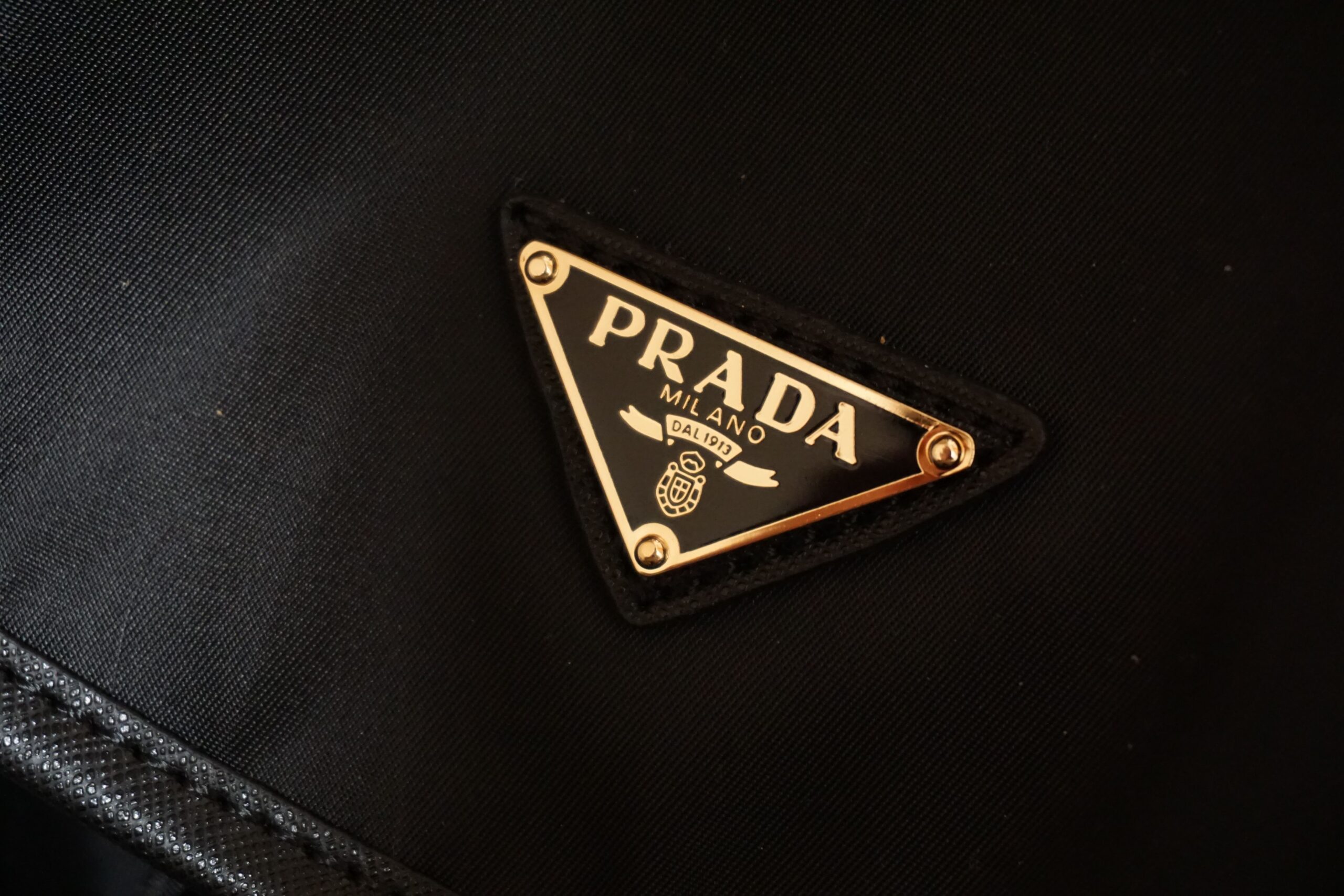
This spring I was determined to find a knockoff of the Prada Re-Edition 2005 bag and I knew Canal Street, on the edge of New York’s Chinatown, was just the place to get it. On a sunny Saturday afternoon, some friends and I took the C train downtown. The Canal Street subway station was cramped and dingy—a harbinger of what lay ahead.
Up on the street, the sidewalks were packed to the brim with people. As we walked through the district, known for its counterfeit items, I tried to avoid awkward encounters with street sellers offering me fake Louis Vuitton wallets and bracelets. I was amazed at how much existed in one street: counterfeit clothing and accessories, grams of weed, Chinese restaurants, a McDonalds. It felt like several worlds squished into a single mile.
Overwhelmed with options, I scoured through sellers to find the best counterfeit Prada purse—an iconic handbag that was re-released a couple of years ago by the Italian house and quickly became the “it-bag” of the moment. I looked through items that were displayed gently on a blanket-covered floor, in case a police officer came by and the seller needed to pick everything up and run. There were hundreds of options, although none of them were what I was after. I found a couple with lopsided “Prada” logos and some colors that the original bags aren’t even offered in. All the while, a crowd of shoppers breathed over my shoulders and slowly pushed me out of the way for their turn to look. In hopes of finding a great knockoff, I continued on my search.
As I walked, several women came up to me, whispering, “Do you want a bag?” Caught off-guard and a bit frightened, I said no. In the movies, I had only ever seen people go to sellers, I’d never expected sellers to come and find you instead. I didn’t want to be scammed while trying to find a scam. I quickly realized, however, that many serious sellers have stopped openly selling on the street. New York City has been cracking down on counterfeits lately, and this was sellers’ way of coping with the changing times. I told the next woman who came up to me that I was interested in looking at what she was selling, and she quickly handed me a pamphlet of all the items she sold. It was more like a menu, really. I saw every bag, hat, wallet and bracelet she had at her disposal, and all I would have to say were the magic words: “I want this one.” If she didn’t have an item I wanted, she would take me to what seemed to be a business partner—a neighboring saleswoman with more options.
Once I picked out my purse, we bargained. She wanted $80 for the fake Prada but I said, “I’m not paying $80 for a bag I can get somewhere else for $35.” Which was true. I began looking at the other seller across the street when all of a sudden the woman whispered, “$40.” I nodded and she quickly ran away to an unknown location. While waiting I got anxious—buying counterfeit goods felt illegal, though apparently in New York it’s not. It also felt morally wrong. Soon she returned with a black trash bag containing my contraband Prada. She quickly left me and disappeared into the crowd of people. Once my deal concluded, my friends and I left with my black trash bag feeling triumphant but dirty. An experience that is so quintessentially New York City made me feel trashy, just like my shopping bag.
These days, though, Canal Street is far from the only option for those seeking knockoffs. Instead of scouring through blankets on a street squished by people, feeling overpowered by the smell of a joint, you can now simply walk into a retail store and instead of buying a counterfeit, buy a dupe.
Yes, a retail store. Why? Because dupes are perfectly legal to buy and sell.
Dupes. You’ve definitely heard of them. They’re everywhere: Tiktok, magazines, websites, the Washington Post. It sometimes seems as if dupes are more popular than their originals. But what exactly are dupes and, most importantly, how are they legal if counterfeits are not?
The term ‘dupe’ was coined several years ago to describe duplicates. There are dupes for everything now. Clothes, beauty, accessories, home goods, kitchen gadgets – you name it, there’s a dupe. Most notably, however, dupes are dominating the fashion industry. Fast fashion brands like Zara, H&M and Shein sell mostly duped items from big fashion brands like Dior, Chanel, Gucci and more. The Prada bag I so desperately sought on Canal Street now exists as a dupe at an H&M store.
Dupes have become a new way to shop, dress, buy and sell, with their popularity reaching new heights on a weekly basis. Thanks to social media apps, dupes boomed during the coronavirus pandemic. While people were stuck at home, they turned to Tiktok and Instagram to shop. However, big luxury brands weren’t focusing on advertising their items on these platforms.
Instead, influencers and ‘Tiktokers’ were promoting their impromptu cheap Covid purchases. During the pandemic, people didn’t have the luxury (or the displeasure) of going down to Canal Street and looking for a counterfeit. So, instead, the internet popularized these “dupes” that look the same as an original item without technically being a counterfeit. With nothing else to do, might as well buy a dupe.
“Do the best dupes” “There’s a better dupe,” and “Designer Dupes” are all titles of Tiktoks promoting dupe purchases. Most of the people promoting their purchases, however, touted the price. Because not many people can pay $600 for a belt, they’ve turned to alternatives. Fast fashion brands have made a point to duplicate items too expensive for many people to buy. This same $600 belt will probably be sold for $40 at Zara—and it will sell out in minutes.
“You’re looking for a literal carbon copy of the dress but for a cheaper price,” said CT Jones, who wrote about dupes for Rolling Stone. Although a dupe lacks the logo that comes with an item, it’s essentially the same thing. “They do not care about the actual dress, they just want the look of it.”
This idea of a “micro trend,” one that arises quickly and for such a small amount of time, accelerates dupes’ popularity. Normal trends last a couple of months, maybe even a year. A micro trend, however, lasts a couple of weeks to a month, forcing people to jump on the bandwagon before it fizzles out. “The mode of consumption is accelerating and TikTok is helping it,” says Jones. With the rise of TikTok, where 60 seconds is already a painfully long video, people are getting more impatient by the day. Once a trend is solidified, the next week people are rushing to buy what is new.
Although designers essentially create long-term trends, their items are too expensive for a lot of people to buy. Designers and luxury fashion companies like Chanel, Dior, and Prada create designs that eventually trickle down to the fast fashion companies. Although this usually happens quickly, micro trends are so accelerated that by the time it gets to cheaper alternatives, people don’t want them instantly anymore, creating more of a long term trend. So people resort to quicker trends that are created on social media and are sold by these fast fashion brands, whether they be small or large.
“On the one hand, they’re using TikTok to grow this brand. But at the same time,” said Jones in our interview, “you’re promoting Amazon to make a cheaper version of the dress.”
Kelsey Kotzur, a TikTok Influencer with more than 150,000 followers, promotes dupes, and enjoys them herself. Because of their popularity, Kotzur’s videos on dupes gain more views, comments and attention than her other types of videos.
“I am all about dupes,” said Kotzur, as she raved about her duped Bottega Veneta Jodie bag that she got for $20 on Amazon. “I am trying not to waste my money.”
Kotzur said she couldn’t afford the real Bottega bag so she decided to take the plunge and find a cheap dupe, which to her surprise, has turned out to be a great purchase. The bag has made it through a couple of years, including trips and nights out, without a scratch.
Dupes are almost identical to the original item, but go for less than half of the price. A lot of people see dupes as a great solution to accelerating fashion trend cycles. If you were to keep up with these insanely paced trend cycles, you’d be having to pay thousands and thousands of dollars to stay afloat. Dupes are the perfect solution for that conundrum.
“How is everyone supposed to keep up all the time?” asked Kotzur. “Just the other day I bought this Orseund Iris top and it was so expensive. The next day, I went with my friend and she had the same top from Abercrombie.”
Dupes are taking the world by storm and have successfully differentiated themselves from their counterfeit siblings. Although counterfeits are taboo and kept hush-hush, dupes are sold at chain stores, advertised on social media, and recommended to others. Kotzur says that the “Orseund Iris top was $300 and I would’ve happily bought the Abercrombie version which was $60.”
The majority of dupe culture’s popularity comes from social media, specifically TikTok. Kotzur says that her videos focused on the way dupes perform better and garner more views than her other videos. “I see a lot of people saving those videos,” Kotzur said. The posts are usually flooded with comments like, “Omg I’m screenshotting this,” or “Where can I find the link to buy?” People are going crazy over dupes, and it seems like it’s become an addictive way to shop. In my interview with CT Jones, they declared that it is selfish, and that we think we are entitled to owning everything. On the other hand, Kotzur says it breaks down barriers that were created in luxury fashion and it therefore promotes more accessibility in the fashion industry. Kotzur even believes that “dupes are never going away.”
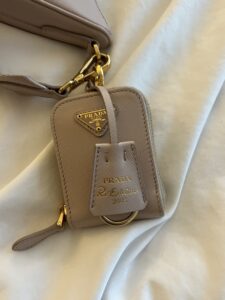
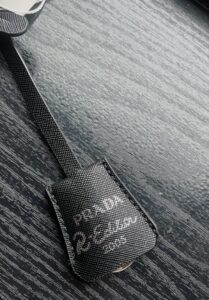
Once I got home, I took a closer look at my Prada Re-Edition bag, or rather Chinatown’s own “Re-Edition” bag. I started examining its shape and build. At first glance, there were no discrepancies. My black, nylon bag looked as if I’d spent $1,500 at Prada’s store on Fifth Avenue. It was the same black color, it had the same Prada logo, same strap, and same decorative detailing. Inside a nightclub with dim lighting, no one would notice. However, on close inspection, I could see that the Prada logo it so fearlessly wears on the front has the p and r letters spread too far apart. It almost reads P RADA instead of the actual PRADA. The strap handle has a cardboard-quality fabric that almost feels like it scrapes you when you put it over your shoulder. And of course, the decorative detail outlining the name of the bag wasn’t even spelled correctly, instead reading “R-Edition.”
I decided to compare my counterfeit Chinatown bag with a dupe. Because dupes are in fact legal, I strolled to a store I knew would carry the same style. Steve Madden was just the place. I noticed the bag at the back of the store, styled next to some bright green heels that give Bottega Veneta’s same heels a run for their money. I saw the bag was essentially the exact same thing as Prada’s—same color, build, style, strap; the only thing it was missing was Prada’s logo. Its quality was the same as Chinatown’s bag, and I participated in a completely innocent act of buying a copy right inside of one of America’s largest shoe retail stores for $84.
Both bags, dupe and counterfeit, are successful in their goal to deceive. As previously mentioned, anyone a couple feet away would mistake my duped bag from Steve Madden as the real Re-Edition Prada bag. So then why buy the original in the first place? While counterfeit knockoffs are taboo and frowned upon, Gen-Z has created its own loophole.
“The big thing about these brand items is not that you’re buying it because it’s necessarily fancy and looks good,” said Anthony Velez, a renowned luxury goods authenticator and the owner of Bagriculture, a luxury goods authentication company based in New York. “You’re also buying the warranty and the guarantee of craftsmanship.” Velez has seen his fair share of luxury handbags, from my Prada Re-Edition to Louis Vuitton to Hermes’ Brikins.
“Whether it’s fake or unlicensed, it is the same exact thing,” he said.
The terms dupe and knockoff, along with pirated and counterfeit, have been used interchangeably for decades, as confirmed by Douglas Hand, a fashion lawyer and partner at the law firm Hand, Baldachin & Amburgey LLP. He says that when dealing with cases regarding copying and stealing, all terms are essentially the same. It’s only outside the courthouse that the two terms have recently separated.
“Dupes are just a clever way to market the counterfeits,” said Velez, because at the end of the day, the bag being duped or ripped off will not have the guarantee that these luxury brands are known for. With a real bag, you can have your bag’s leather replaced, the hardware fixed and other repairs or alterations it may need.
Because this luxurious guarantee comes with a hefty price tag that not everyone can afford, a counterfeit at times seems like a clever choice. “It is a status symbol,” says Velez, “if someone thinks it’s real, they may treat you differently.”
Historically, that has been the driving force behind the knockoff industry, as seen in pop culture like Sex and the City. It has, however, always been something frowned upon or to be ashamed of. With the rise of a tech-savvy and defiant generation, Gen Z popularized a different way—the dupe.
Gen Z has successfully created a way in which we can enjoy nice items without an enormous price tag. At Steve Madden, I wasn’t the only one looking for that Prada bag. There were a couple of other girls trying to get their hands on that same bag, and in different colors. Once the item has been bought and secured, they proceed to talk about what a great bargain it was. I mean, a Prada Re-edition for $80? Who wouldn’t think that was a steal?
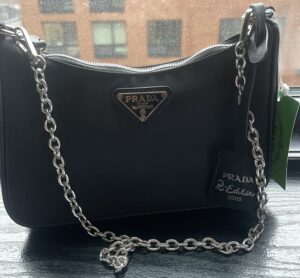
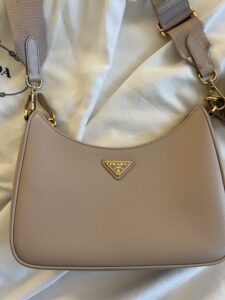
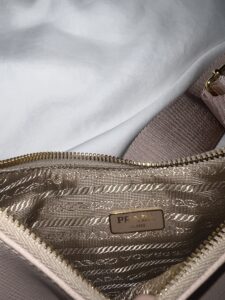
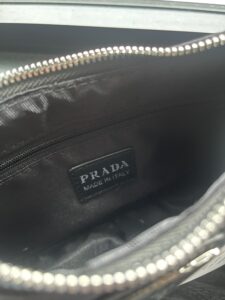
The images above show the difference between the counterfeit Prada bag (the black nylon to the left) and the authentic Prada bag (the nude bag to the right). At first glance, they look identical, regardless of color and texture. However, on closer look, the logo on the counterfeit bag is too big and has weird spacing between the letters. The logo on the inside of the bag is also entirely different, with the authentic bag’s logo engraved in metal and the counterfeit logo stamped on a piece of fake leather. The inside of the authentic Prada bag is lined with satin, elevating the bag’s price, while the inside of the counterfeit bag has no lining.
Aren’t dupes just glorified knockoffs? Well, no. A knockoff is an exact replica and/or copy of an original trademarked item. For example, you can buy a black Boy Chanel handbag that retails for $6,000 for $40 on Canal Street. Same design, color and logo. The knockoff version actively impersonates the Chanel bag, while the dupe just resembles it. According to Jones, “a common version of a dupe is something that takes a designer item and then mimics it to a point of outright copy.”
While selling a fake handbag is illegal, dupes are perfectly legal, and sometimes even encouraged by other users on social media. Why buy Bottega Veneta’s Jodie Bag for $2,700 when you can buy Zara or Amazon’s dupe for $20? Why the discrepancy between reactions for knockoffs versus dupes? Jones says that dupes are “subverting the narrative of what is taboo,” and I mean, it’s essentially the same thing without saying they’re the same thing. But that’s just it – one of them says what they’re pretending to be, while the other is secretive about it.
While knockoffs are illegal and sellers can face prison sentences between five and 20 years, dupes fall in the gray area of trademark and copyright law outside the influence of lawyers and brands. Douglas Hand says that designs themselves aren’t protected under current intellectual property law. “What Zara and H&M do isn’t illegal,” says Hand. “They may look identical to those designs, but the designs themselves are not protectable under current intellectual property law.”
To understand dupes, one must understand trademark law. Trademarks protect manufacturers, designers and creators from having their creations copied insofar as they’re identified with a distinguishing marker, such as a brand name, logo or slogan. So when you see a $6,000 Boy Chanel Bag with the double crossed C’s on the opening clutch, know those C’s are trademarked. Since dupes circumvent these distinguishing markers, retailers are able to use the same design as the Chanel bag, without using the double crossed C’s. The dupe is a bag that looks like Chanel, without it pretending to be Chanel.
A trademark is infringed upon when another person uses a device (or a mark) so as to confuse or deceive. Sellers across New York City selling Gucci wallets and Rolex watches on sidewalk blankets are all infringing on trademark law because their products aren’t actually produced by Gucci or Rolex, yet they still use their logos. Hand says that “unless there is a feature of those designs that’s been trademarked, like Louboutin’s red sole, it isn’t illegal.”
In other words, since dupes aren’t using logos on their items or any other trademarked identity – like Christian Louboutin’s red sole or Tiffany and Co’s blue boxes and bags—they’re not infringing on anyone’s trademark. Trademarks protect the manufacturer from having their word, phrase, symbol, product shape or logo used without their consent. Dupes don’t appropriate any logos; instead they copy designs.
Many people around the world buy dupes for the design and general look of the item. The logo has nothing to do with it. “It’s a cute version of what I wanted it to look like,” says Kotzur about her duped Bottega Veneta bag. Although you would think designs are also protected, United States law doesn’t really protect designers from their ideas being copied. In this case, trademark law and infringement have nothing to do with it; instead, dupes are majorly concerned with copyright law.
Copyright is a form of protection granted in the U.S. Constitution for “original works of authorship fixed in a tangible medium of expression.” This includes “literary, dramatic, musical, and artistic works.” I know what you’re thinking: can’t fashion designs be copyrighted? Well actually, no.
Fashion isn’t considered to be art or creative expression in the eyes of the law. Fashion is considered more as its general function – as clothing. Clothes are something we all need; they are a basic human necessity.
“For fashion, specifically talking apparel, it becomes very hard to think of a non-functional design feature” says Hand. He says that even though a designer might create a cool opening on a piece of clothing, it still has a functional element: “it’s where your head goes through.”
The law sees clothes as having a utilitarian purpose rather than being about artistic expression. We all need clothes, and if the United States were to copyright clothes, no one would be able to afford them. Hand says that the law does not see clothes as a form of art or creative creation. And, thanks to the Geneva Conventions, most European countries agree and follow U.S. copyright laws. So there’s no escaping for these designers.
“Intellectual property law wants people to have choices amongst functional items,” says Hand about copyright, “therefore every brand can use the same collar width—like Burberry’s for example.”
Even if designer Manolo Blahnik wanted to copyright his classic Hangisi heels, he couldn’t, because the law thinks having heels is utilitarian and necessary. In simple terms: the law doesn’t recognize fashion as art, it’s just seen as clothes.
I doubt the founding fathers of the United States really thought about fashion’s development when coming up with copyright and its limits, although I think they would’ve allowed for some revision. I mean, who would’ve thought that people would be taking advantage of this gap in the law to make copies of other people’s designs to sell at a fifth of the price?
As with every rule there will be exceptions. One way something in fashion could be copyrighted is when “a portion of your clothing, if taken off the clothing, could independently meet the requirements of copyright protection.” For example, the “Van Cleef & Arpels material” has been copyrighted because the materials they use for their pendants, even if seen without the necklace, are very clearly Van Cleef & Arpel. Brands can copyright certain fabrics or patterns, although it’s rare. Many fabrics and patterns look similar, which makes this whole thing even trickier. This gray area is called fair use.
Dupes fall into this gray area. Fair use falls under copyright law and is a doctrine which allows some leeway in copyright. It has some parameters, but for the most part, it allows people to wiggle around copyrighted items. Thereby spawning the dawn of the dupe during the pandemic.
Fair use describes the nylon material on my Prada dupe, for example, so making a black nylon bag is legal. Because the design of my bag was never copyrighted, companies like H&M and Steve Madden are perfectly able to use black nylon and recreate the same bag, without the Prada logo. Thereby creating a Prada Re-Edition 2005 dupe bag.
Fair use allows brands to sell products as long as these brands are not deliberately causing any consumer confusion. In the U.S. Supreme Court case KP Permanent Makeup Inc., v. Lasting Impression I, Inc, the court found that the defendant was not causing any customer confusion. The burden of proving that there was indeed confusion lies on the entity holding that trademark, and in this specific case, KP Permanent Makeup Inc. was not able to prove that there was any confusion from the defendant’s use of the term “microcolor”to describe their permanent makeup “color pigment.” This happens as well with dupes.
Dupes never use the logo from the items they are copying, and therefore cannot be said to cause confusion. Counterfeits cause confusion, not dupes. Although counterfeited items are illegal to sell, dupes are a nice and cost friendly way to continue keeping up with trends and designers. And the best part — it’s totally legal.
Because of dupes’ gray area, luxury brands aren’t the only ones affected. In fact, most luxury brands don’t have the time, money, or care to crack down on all the dupes that are counterfeits roaming in the world. Their profits alone make them cushioned enough to forget about those pretending to be Louis Vuitton, or in my case, Prada.
A high-up employee at Prada, who asked to remain anonymous, told me that her company isn’t worried about knockoffs or dupes, saying that the people buying those dupes are aspirational clients but it doesn’t interfere with their business because their client base is so strong. I mean, it does make sense. People continuously buying thousands of dollars worth of items aren’t really in the market for dupes. “It’s not even really an issue for us,” says the Prada employee. When luxury brands see these counterfeits and dupes, they don’t see competition.
However, the Prada employee does say the dupes are pretty bad. “I’ve seen the baseball caps,” says the employee about her brand’s famous accessory, “I’ve seen that the logo is basically on the forehead while ours goes behind the ear.”
“It’s not really something that crosses our mind because our brand integrity is so strong,” continued the Prada employee about her company and its clientele. Luxury brands aren’t worried about dupes and their increasing popularity because of their loyal customers. People spend thousands of dollars to get an original item; a lot of the people buying dupes, according to the employee at Prada, were never going to be in the same market.
Apart from that guarantee buying a luxury item grants you, you also get that piece of mind of having the best quality possible. “Of course the price point at our company is much higher,” says the Prada employee. “There is excellent client service and after care that, you know, you do not get at these fast fashion brands.” Dupes, on the other hand, are made from cheap fabrics, and usually in unethical ways. Elle Australia recently published an article titled “Why Is Shein So Bad? The Fast Fashion Brand, Explained” confronting Shein, the Chinese fast fashion conglomerate about their unethical labor practices when making duped items. The writer, Ava Gilchrist, listed the key issues at hand with the brand, like how a 2021 sustainability and social impact report reported that a whopping 66% of their suppliers’ factories “violated their code of conduct.”
“It’s almost like imitation is a form of flattery,” says the employee at Prada about dupes. But while her company has the privilege of not worrying, smaller brands and designers don’t have that same luxury and comfort.
Meg Cohen, the designer of her namesake brand, felt victimized and powerless when faced with that situation. “In 1992, I developed a scarf at an English factory that they had never made before,” says Cohen. Her cashmere scarf has fringes on the length of both sides, not just on the ends. “A few years later, I got a call from my mill that someone from Burberry had bought one of my scarves and sent it to a factory to manufacture it in their pattern.”
“I was featured in British Vogue and Harper’s Bazaar for my Double-Fringed Scarf,” says Cohen, proud to have been able to show off her creation at the time. “I was the first person to do this scarf.” In fact, the scarf was so successful that Paul Smith, a major English brand, wanted to buy Cohen’s stock of the scarf. In only a matter of months, Cohen started selling her scarf at different stores like Bergdorf Goodman and Barney’s and, in London, at Brown’s, Paul Smith and Harvey Nicols. Her destiny, however, was that much more shocking.
Burberry, a global luxury brand estimated to be worth around $10 billion, overmatched Cohen. For Cohen to sue Burberry for stealing her design and essentially being “duped,” she would have to have spent thousands of dollars, plus time, and physical and emotional distress. Because her small company couldn’t afford that, she was forced to let it go. “I didn’t know what to do,” says Cohen, “I kind of froze.”
Her predicament reflects that of most small brands and designers; they tend to be the most ripped off, or duped, because they can’t afford to fight back. Worst of all, no one notices because they aren’t as well known, making them more susceptible to theft. Cohen’s good friends at the time, Andy and Kate Spade, were the ones to break the news to Cohen about her scarf finally being available for sale as a dupe. Cohen said the three were having a drink in Paris when all of a sudden they told her they had seen her scarf at Burberry. “Kate Spade was upset they knocked me off too.”
At the time, developing a new type of scarf was a difficult task. However, Cohen had managed to do it. Her Double-Fringed Scarf was a best-seller—for Burberry, that is. The English brand sold millions of dollars of what they labeled their Happy Scarf.
“They basically knocked me off,” says Cohen about Burberry. “It takes a long time to come up with a good idea.” Now she says sees copies of it everywhere —she says that Burberry’s version has been duped as well. “Unfortunately, it happens a lot,” says Cohen, who adds she was just shocked it happened so quickly. “People started copying Burberry not knowing it was my design.”
Burberry’s theft of Cohen’s Double-Fringed Scarf design was one way to ‘dupe.’ As much as fast-fashion brands are at the forefront of copying and selling luxury items at a fraction of the price, luxury brands are also to blame. Like Cohen, many small designers are preyed on by global brands. Smaller brands are also targeted by fast-fashion companies. Marcelo Gaia, the owner and designer of the brand Mirror Palais, was fed up with his duped Fairy Dress selling on Amazon for a low price with cheap quality. Gaia turned to TikTok to vent their frustrations in a video.
In a video where they stitched another TikToker’s video about someone shaming dupes, Gaia says “it’s definitely f****d up for any company to be selling direct knockoffs of another company’s product, especially a small business.” Dupe culture has gotten out of hand; dupes have completely turned into blatant copies. They are made in sweatshops and are straight-up copying designs. “Someone is slaving away over these recreations of my dresses and probably being paid really unfairly and probably working in really bad conditions,” says Gaia in their video. Dupes are slowly finding their way back to their original meaning: being a knockoff.
Because of dupes’ ridiculousness, TikTok has created a sub-trend where people find humorous dupes for basic items to make fun of the people who are avid “dupe buyers.” Today, people will buy white socks that look like Alo Yoga’s white socks and will call white socks a “dupe.” Since when have white plain socks been a dupe? They’re just socks. In response to this, people have started making fun of dupes by calling them “dooops” and will make videos like a phone being a dupe for a computer, or a Lexus being a dupe for a Mercedes-Benz, to name a few. At Target or Walmart, videos of people finding funny dupes for other random items have become viral. The dupe slowly creeps back to its shameful place.
Will dupes suffer the same social fate as counterfeits? Only time—and TikTok—will tell.